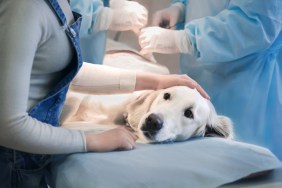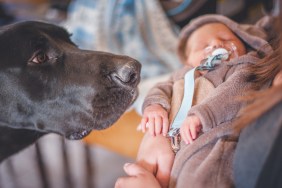You and your buddy are out on a walk when Fido spots a tennis ball rolling his way. He lunges forward, grabs the ball in his teeth, and gruffly growls, “It’s mine.”
Canine Possession Aggression (CPA) comes in two forms–food guarding and object guarding, the act of assertively protecting toys, chew treats (such as bully twists, pig ears, etc.), and things snuck from you such as socks, underwear, and items from the trash can.
So why does your furry friend feel he has to jealously guard things from you? Because you’re going to take it from him! You have in the past, haven’t you? When he was a pup, he wandered through the house and yard grabbing everything he could fit in his mouth. When you saw him with one of your best shoes in his mouth, you screamed “No” and snatched it from him. You probably followed that up with “Bad Puppy!” to boot. Every time he found some wonderful new goody, someone grabbed it away. After awhile, your dog became fed up with this. He may start with a growl, then a snarl or snap, and before long good strong bite.
It’s All in the Mouth
To avoid a bite, start by getting your dog used to you touching his mouth. Begin when he is a puppy–brush his teeth, flap his flews, open his mouth and say, “Hello?” Reward him with a treat when he accepts this touching.
If your dog has possession issues with things like rawhide chews, buy a long one. Hold one end and offer the other to your dog. He will not enjoy this as much as when he can run and hide with it, but as he gets used to this routine, he will become more accepting of it.
Deal or No Deal?
Your dog should view you as the master and provider of all good things. You need to tightly control what he gets and when he gets it. Keep all but a few toys and chews on the floor at any one time. When you offer a new chew or toy, give the command “take it.” When you are done playing or want the chew toy time to stop, give the command “drop it,” take the item and put it away. Then, give him an item in exchange for the one you took.
You can help the exchange by giving him something he likes better in exchange for dropping the item you want to take away. You will need to find out through time and trial what those “better” things are. It could be a favorite toy, a certain treat, or even a walk. For example, if playing with a ball is fun for your dog, but not as fun as a walk, then that would be the exchange. If he loves a certain toy, but would gladly give it up for a special treat, then that is your exchange. If he keeps getting into the garbage, but stops when you pull out a chewy, then by all means, keep a stock of chews on hand.
In theory, you and your family, as leaders of the pack, should be able to take any object from your dog–but not every dog abides by these rules. In some circumstances, the dog feels he is pack leader. In others, the dog’s purpose is not clear.
CPA may be anxiety-based or come from past experiences. If you can determine what drives these behaviors, you can avoid situations that allow the dog to see possessiveness as a suitable response. If the problem is out of hand, get the help of a professional, such as a certified dog trainer or animal behaviorist. They can evaluate the situation and design a personalized process for you and your dog.
Source: Adapted from the ASPCA




